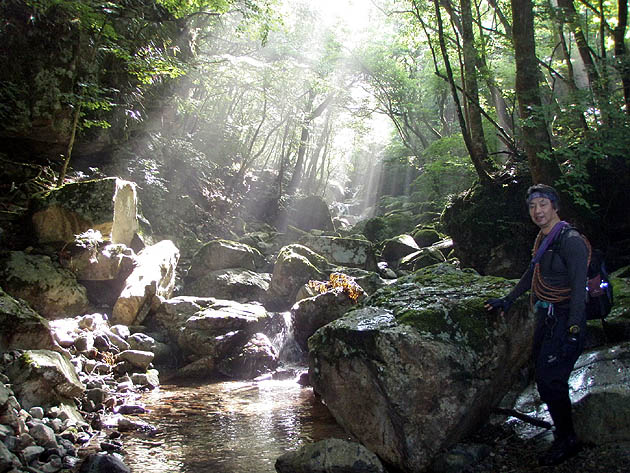
Japan is a mountainous country with many streams. It is very exciting to climb up a mountain stream. Walking in the flow, climbing up waterfalls using rock-climbing skills, and, if necessary, swimming in deep pools, we can enjoy the spiritual beauty of the stream. When I was young, I was totally absorbed in the “water climbing”.
There are many beautiful streams full of waterfalls in Nara Prefecture next to Osaka. It takes three or four hours to get there by car. My friends and I often visited there. Usually we arrive there in the evening, and stay by a river. We often fish trouts and roast them on a fire. Some drink; others sing. Sometimes we hear a voice of deer; sometimes we see the moon in the narrow sky between mountains. Early in the next morning, we begin to walk. All day long we play in the region of the Divine.
I say the “Divine” to translate a Japanese word, kami. Sometimes the word is translated as “god”, “spirit”, or “fairy”. They are not exact. I prefer the word, “Divine”, because it is adjective in origin. Kami is not necessarily an entity but a process. We can feel something when it appears. We do not assume some existence behind the phenomenon. The process itself is divine. Mircea Eliade called this “hierophany”. He wrote: [1]

Man becomes aware of the sacred because it manifests itself, shows itself, as something wholly different from the profane. To designate the act of manifestation of the secred, we have proposed the term hierophany. It is a fitting term, because it does not imply anything further; it expresses no more than is implicit in its etymological content, i.e., that something sacred shows itself to us. It could be said that the history of religions – from the most primitive to the most highly developed – is constituted by a great number of hierophanies, by manifestations of sacred realities. … In each case we are confronted by the same mysterious act – the manifestation of something of a wholly different order, a reality that does not belong to our world, in objects that are an integral part of our natural “profane” world.
Not only in Nara, but also in all over Japan, my team made expeditions to many streams. I wasted my young days in streams. There I learned many things that cannot be learned from the book. At last, however, the time had come. When I climbed a big waterfall of Mount Esaomantottabetsu in Hokkaido, I decided to retire from the water climbing, in 2004 at the age of 56. Muscle power was still enough, but the sense of balance was deteriorating.

After that, I only visit streams to fish for trout. For these two days I was in Tenkawa Village of Nara Prefecture. I do not enter to tributary streams with waterfalls, nor do I swim in pools. Nevertheless, the days were exciting. I arrived at the village in the evening. By a small stream I made a fire and cooked a small supper. Everything was the same as the old days. I felt the hierophany of the Divine with ara-mitama, the rough spirit. The Divine with ara-mitama, who lives in the nature, can be softened by rituals, and becomes to ones with nigi-mitama, the fine spirit. When my team entered to a branch stream to climb waterfalls, we offered up some foods to the Divine and prayed in the ancient language. If we did not do so, the Divine would rage at us. This is the basic logic of Shintoism, the Japanese traditional religion. This time, I did not perform the ritual, because I do not enter into the house of the Divine but only play in front of his gate.
In this village we can find two kinds of trout; amago (Oncorhynchus masou) and iwana (Salvelinus leucomaenis). Both are landlocked fish that live in the river and do not go down to the sea. They mature with characteristics of young fish. This is called “neoteny”. Anyway they are very beautiful and, first of all, tremendously tasty. Next day I enjoyed many gifts from the Divine all day long.
[1] Eliade, Mircea: The Sacred and the Profane. Harcourt, Orlando, Florida, 1959, p.11.

